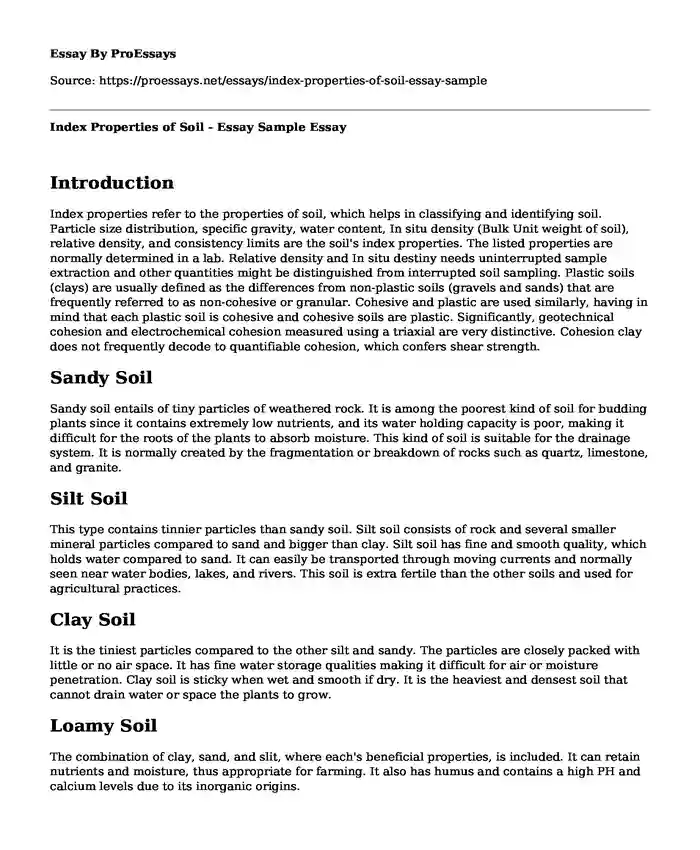Introduction
Index properties refer to the properties of soil, which helps in classifying and identifying soil. Particle size distribution, specific gravity, water content, In situ density (Bulk Unit weight of soil), relative density, and consistency limits are the soil's index properties. The listed properties are normally determined in a lab. Relative density and In situ destiny needs uninterrupted sample extraction and other quantities might be distinguished from interrupted soil sampling. Plastic soils (clays) are usually defined as the differences from non-plastic soils (gravels and sands) that are frequently referred to as non-cohesive or granular. Cohesive and plastic are used similarly, having in mind that each plastic soil is cohesive and cohesive soils are plastic. Significantly, geotechnical cohesion and electrochemical cohesion measured using a triaxial are very distinctive. Cohesion clay does not frequently decode to quantifiable cohesion, which confers shear strength.
Sandy Soil
Sandy soil entails of tiny particles of weathered rock. It is among the poorest kind of soil for budding plants since it contains extremely low nutrients, and its water holding capacity is poor, making it difficult for the roots of the plants to absorb moisture. This kind of soil is suitable for the drainage system. It is normally created by the fragmentation or breakdown of rocks such as quartz, limestone, and granite.
Silt Soil
This type contains tinnier particles than sandy soil. Silt soil consists of rock and several smaller mineral particles compared to sand and bigger than clay. Silt soil has fine and smooth quality, which holds water compared to sand. It can easily be transported through moving currents and normally seen near water bodies, lakes, and rivers. This soil is extra fertile than the other soils and used for agricultural practices.
Clay Soil
It is the tiniest particles compared to the other silt and sandy. The particles are closely packed with little or no air space. It has fine water storage qualities making it difficult for air or moisture penetration. Clay soil is sticky when wet and smooth if dry. It is the heaviest and densest soil that cannot drain water or space the plants to grow.
Loamy Soil
The combination of clay, sand, and slit, where each's beneficial properties, is included. It can retain nutrients and moisture, thus appropriate for farming. It also has humus and contains a high PH and calcium levels due to its inorganic origins.
Soil Conditions
The soil's capacity to function in the land use and environment borders to maintain organic productivity, human health, animal health, enhance the plant's growth, and sustain environmental health. There are two conditions of soil saturated condition supporting microphytic communities' development and anaerobic conditions that support microbial populations modified to anaerobic habitats (Glinski, 2018).
Soil structure defines how clay, slit, and sand particles are formed together soil organisms, and organic matter affects soil structure. Organic matter, clays, and materials excreted through soil organisms clamp soil particles to create an aggregate. It is essential in plant germination, modifying water and air movements, which influences root growth and nutrient availability.
Conclusion
Compressibility develops an essential soil parameter needed in design consideration. Shear strength helps in resisting failures whenever strong forces are applied to the soil. Compactness involves increasing the soil's density through the packaging of soil particles closely to help reduce air volume in the plant.
Reference
Glinski, J. (2018). Soil physical conditions and plant roots. CRC press.
Cite this page
Index Properties of Soil - Essay Sample. (2024, Jan 01). Retrieved from https://proessays.net/essays/index-properties-of-soil-essay-sample
If you are the original author of this essay and no longer wish to have it published on the ProEssays website, please click below to request its removal:
- Essay Example on the Human Genome Project (HGP)
- Annotated Bibliography: Animal Abuse
- Different Regulations of GMOs in Different Countries
- Essay Sample on Townsend's Big-Eared Bat: Big Ears, Big Appetite
- Prairie Vole Empathy - Annotated Bibliography
- Essay on Grey Parrots: Psittacus Erithacus - Medium Sized, Black-Billed & Varied Colours
- Altitudinal Migration in East African Birds: A Comprehensive Ringing Recovery Study







